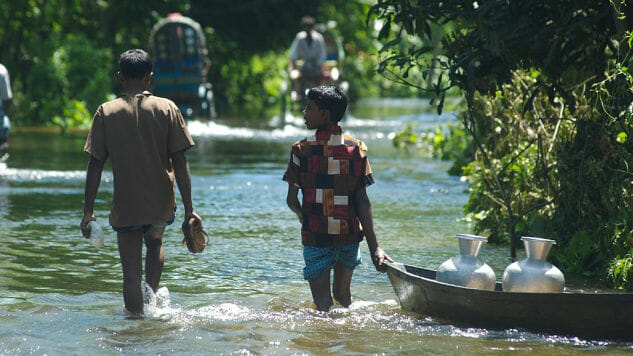In India, Mumbai Suffers its Own Flood
Monsoon season arrives
David Greedy / Getty Politics Features Mumbai
Harvey is flooding Houston, but rains are also falling hard on the other side of the word. The Indian city of Mumbai and its twenty million citizens are getting pummeled with moisture right now.
If the storm continues, it will likely be the worst Mumbai flood since July 26, 2005. The summer monsoon season is both curse and lifeblood to South Asia: it arrives between May and September, when the warm airs come calling from the Indian Ocean, and hang over Myanmar, Sri Lanka—and, of course, India. The wet season feeds the aquifers and irrigates the crops and provides electricity. And sometimes it rains, and doesn’t stop.
Per CNN:
Heavy rainfall paralyzed parts of the Indian financial capital of Mumbai on Tuesday, as traffic chaos sparked by flooding streets prompted officials to warn residents to abandon stranded vehicles and remain indoors. An unrelenting downpour has battered low-lying parts of the city since the early hours of Tuesday, with some areas receiving almost 12 inches of rain. Weather forecasts suggested that the rain will continue over the next 48 hours before it begins to decrease. Vehicles gingerly made their way through waterlogged roadways as residents sloshed through flooded streets — navigating waist-high water in some areas — after being sent home early from offices and schools.
News organizations claimed that thousands of commuters faced significant challenges in making safe passage. Videos posted online told the tale: in one instance, inflatable rafts and dinghies were recorded crossing waterlogged streets. The BBC reported that tens of thousands of people had been displaced. Airlines were grounded and police cautioned the public to stay indoors as much as possible.
The worst stories from 26 July 2005 were of people trying to get home. Don’t be brave. Office is safer than street today.#MumbaiRains
— Shashank Singh ???????? (@RccShashank) August 29, 2017
The city’s manholes flooded just in time for high tide, which rolled into town as the day turned to evening.
The waters are rising, all across the Indian Ocean. According to the Times, more than a thousand people have died in South Asian floods this summer. Last weekend, the Indian Prime Minister Modi soared over the watery catastrophe in Bihar, where an estimated four-hundred people died. Even the mountainous country of Nepal has not been spared the rampaging tide:
… as sheets of incessant rain pummeled the vast region on Tuesday, worries grew that the death toll would rise along with the floodwaters. According to the United Nations, at least 41 million people in Bangladesh, India and Nepal have been directly affected by flooding and landslides resulting from the monsoon rains, which usually begin in June and last until September. And while flooding in the Houston area has grabbed more attention, aid officials say a catastrophe is unfolding in South Asia.
As Sanjiv Shankaran of the Times of India noted:
The damage wrought by the rainfall on 29th August (Tuesday) could have been mitigated if the municipal authorities and state government cared enough. Given the frequent floods in the city, it is apparent that they have not cared enough over decades.
Three factors cause urban flooding- meteorological, hydrological and human. There is nothing anyone in government can do about the first two factors, but failure in the third factor is what leaves a trail of destruction.
Shankaran suggested that Mumbai is overbuilt and land reclamation has led to the current flooding:
The city’s storm water drainage system is a network of surface drains, underground drains and canals which discharge surface run-off into the city’s creeks, river or straight into the Arabian Sea. Perhaps the most important component of the drainage network is the Mithi river which serves as the line of demarcation between the city and its suburbs. Mithi river has over the years been not only been encroached upon, but whatever is left is clogged with solid wastes and plastic. … It is simply not right that Mumbai should crumble so often. The intensity of urban flooding can be reduced.
It is important to remember that at the height of unstoppable fury, we may do much to mitigate what follows. The sky makes its plans; we make ours. As we look towards Houston with sympathy, let us remember Mumbai too, in the height of a wet season. The rain falls equally on us all.